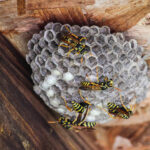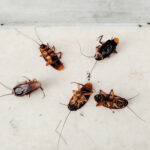Safeguarding Your Warehouse Against Pests or Similar Facility: Proactive Pest Management
Safeguarding Your Warehouse Against Pests or Similar Facility: Proactive Pest Management
 Warehouse environments are highly vulnerable to pest infestations, and keeping pests at bay is crucial to protecting stored goods and maintaining a hygenic, clean facility. Effective pest prevention requires a multi-faceted approach, including regular inspections, proper sanitation, and monitoring.
Warehouse environments are highly vulnerable to pest infestations, and keeping pests at bay is crucial to protecting stored goods and maintaining a hygenic, clean facility. Effective pest prevention requires a multi-faceted approach, including regular inspections, proper sanitation, and monitoring.
By understanding the key challenges posed by each pest category and implementing preventive measures, warehouse managers can minimise risks, protect inventory, and ensure a pest-free environment.
The following guide outlines the main pest threats, prevention strategies, and essential freight and transport handling practices to maintain a secure, pest-controlled warehouse.
Insects
Insects pose a significant threat to warehouses due to their ability to infest and damage stored goods. Common warehouse insects include beetles, moths, and cockroaches. Insect Prevention strategies include:
- Regular inspections of incoming goods
- Proper sanitation and cleanliness practices
- Use of insect monitors and traps
- Sealing entry points and cracks
- Implementing proper storage techniques, such as raised pallets
Rodents
Rodents like rats and mice cause extensive damage to products and structures in warehouses. They can also spread diseases. Key rodent prevention measures include:
- Sealing all potential entry points, even those as small as a quarter-inch
- Proper waste management and regular cleaning
- Use of rodent traps and bait stations
- Keeping vegetation away from the building’s exterior
- Regular inspections for signs of rodent activity, such as droppings or gnaw marks
Birds
Birds, particularly pigeons and sparrows, can create problems in warehouses by nesting in rafters and contaminating products with their droppings. Prevention techniques include:
- Installing physical barriers like netting and spikes
- Using visual and auditory deterrents
- Sealing potential entry points around the building
- Removing food and water sources
- Implementing proper waste management practices
Freight & Transports
Pest prevention in freight and transport is crucial as pests can easily hitchhike on shipments. Key strategies include:
- Thorough inspection of incoming and outgoing shipments
- Implementing a first-in, first-out inventory system
- Proper sealing and packaging of goods
- Regular cleaning and maintenance of transport vehicles
- Training staff to identify signs of pest activity
- Establishing quarantine procedures for potentially infested shipments
Warehouse Pest Prevention Checklist
1. Identify Common Pest Problems
- Recognise common pests in your warehouse (e.g., rodents, insects, birds).
- Understand the risks they pose to products and infrastructure.
2. Understand the Importance of Pest Prevention
- Communicate the business impact of pest infestations, including damage to goods and potential health risks.
3. Implement Cleanliness Standards
- Clean all storage areas regularly, ensuring proper sanitation.
- Ensure trash is disposed of promptly and stored in sealed bins.
4. Establish Proper Stock Rotation Practices
- Adopt a First-In, First-Out (FIFO) stock system to avoid stagnant inventory that attracts pests.
- Regularly check for expired or damaged products.
- Inspect the building’s perimeter for cracks, holes, or other potential entry points and seal them.
- Install air curtains, door sweeps, and weather stripping to block pest entry.
6. Utilise Monitoring and Detection Techniques
- Install traps and monitoring stations to detect pest activity early.
- Use UV fly traps, electric fly killers, and pheromone traps.
7. Explore Integrated Pest Management (IPM) Strategies
- Implement an IPM approach that includes sanitation, exclusion, and monitoring as part of a long-term strategy.
8. Evaluate Non-Chemical Pest Control Options
- Use traps, physical barriers, and natural repellents to minimise chemical usage.
9. Consider Chemical Pest Control Methods
- Use chemical treatments as a last resort and ensure they are applied safely and according to regulations.
10. Investigate Biological Pest Control Techniques
- Explore biological options like predators or bacteria that target specific pests without harming humans or products.
11. Collaborate with Professional Pest Control Services
- Partner with a professional pest control company for inspections, monitoring, and treatment plans tailored to your warehouse.
12. Stay Compliant with Legal and Regulatory Requirements
- Ensure your warehouse meets all pest control regulations required by local and national authorities.
13. Train Employees on Pest Awareness and Prevention
- Regularly educate staff about pest risks and best practices for prevention.
- Provide them with resources to identify and report signs of pests.
14. Create a Pest Prevention Checklist for Staff
- Develop a simplified checklist for daily, weekly, and monthly pest control tasks.
15. Conduct Regular Pest Inspections and Audits
- Schedule routine inspections to identify potential issues early.
- Ensure a pest audit is part of your regular safety procedures.
16. Address Contributing Factors to Infestations
- Review the warehouse layout, humidity levels, and food storage practices that might attract pests.
- Rectify any areas that may contribute to an infestation.
17. Develop an Action Plan for Pest Emergencies
- Establish a protocol for dealing with pest emergencies, including rapid intervention procedures.
18. Utilise Traps and Baits Effectively
- Place traps aSafeguarding Your Warehouse Against Pestsnd baits in strategic locations based on pest behaviour.
- Regularly check and maintain all traps.
19. Educate staff on the Signs of Pest Activity
- Ensure employees can identify common signs of pest activity, such as droppings, nests, or damaged goods.
20. Foster a Culture of Shared Responsibility
- Encourage all staff members to take responsibility for pest prevention.
- Incorporate pest control responsibilities into daily tasks.
Implementing a robust pest prevention strategy is essential for maintaining a safe and efficient warehouse environment. By following the comprehensive checklist and fostering a culture of shared responsibility, warehouses can significantly reduce the risk of pest infestations.
Youngs Pest Control is available for all your warehouse, storage facilities, or factory pest needs.
Take proactive steps to safeguard your warehouse from costly pest infestations. At Youngs Pest Control, we specialise in tailored pest management solutions for warehouses and similar facilities. From rodents to insects and everything in between, our expert team will ensure your inventory and operations remain pest-free.
Call Youngs Pest Control today at 0161 776 9832 or email us at [email protected] for a free, no-obligation consultation. Let us help you protect your business with comprehensive pest control services that keep your facility safe and compliant. Visit youngspestcontrol.co.uk to learn more.





